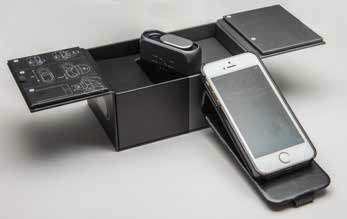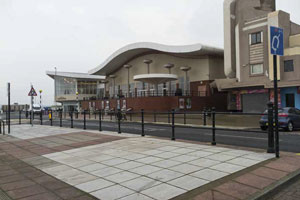articles/Cameras/DxO-One-page2
How to Jazz up an Apple? Add a DxO One! - part 2 of 1 2 3
by Mike McNamee Published 01/02/2016

Open the Box
The DxO is packed in a sumptuous, flap-lid box which can easily
compete with the packaging pioneered by Apple (who spend 3half% of
manufacturing cost on packaging). The initial impression is therefore
good and improves when you pick the DxO out - it is reassuringly solid,
compact and stylish. At 69mm tall, it slips into your pocket unless you are
a male flamenco dancer.
The box also includes a micro USB-USB cable for charging and data
transfer although the latter may also be accomplished by putting the
micro SD card into a dedicated reader.
Attaching to the iPhone
Sliding the lens cover downwards, and then a tad more, flips the Apple
connector out. This is plugged into the iPhone and then the iPhone
itself may be rotated to the most convenient angle. The iPhone needs
to be removed from its cover which is somewhat inevitable but a pain
nevertheless if you normally protect your phone this way.
The free DxO software has to be installed on your phone and then you are
ready to shoot; although the camera will work on its own, it's blind in the
absence of a viewfinder.

As well as good definition, the lens is relatively distortion free.
Settings
From the iPhone you can use gestural swipes to set ISO, aperture, shutter
speed, mode, white balance, exposure compensation and metering mode
- all the things you might expect to see on a DSLR. The UI also provides
sliders for camera or movie setting, file save mode, self timer, flash and
nine shooting modes (sports, portrait, scenery and night shots).
The file options are Super Raw, Raw and JPEG. The Raw files are delivered
as DNG files and need software to 'unpack' and process them. The ISO
ranges from 100 to 12,800 and an Auto ISO feature is also available. The
shutter speeds range from 1/8,000s to 15s.
The aperture on the 32mm (equivalent) lens is f1.8 and can be
incremented to a sensible f11 (presumably diffraction kicks in after that
point). The shoot modes are P, A, S and full manual.
Focusing is activated by a half press on the shutter release.
In Use
The combination of phone and camera is similar in use to a compact
camera with an LCD screen. The grip of the camera to the phone is
reasonably secure but the rig feels a little insecure, you always worry that
one piece or the other will detach itself. Getting your shots level proved to
be a little bit of a problem. There is a lanyard point for the camera itself but
most users would worry about the phone dangling in the air. The phone
continues to work with the camera in use.
In use we found that the 32mm lens was wide, good for social events and
fun shots but too short of flattering portraits. We also found ourselves
taking lots of shots of the floor as we fumbled the rig about with cold
hands.
Please Note:
There is more than one page for this Article.
You are currently on page 2
- How to Jazz up an Apple? Add a DxO One! page 1
- How to Jazz up an Apple? Add a DxO One! page 2
- How to Jazz up an Apple? Add a DxO One! page 3
1st Published 01/02/2016
last update 21/07/2022 08:49:43
More Cameras Articles
The Society of Photographers Convention and Trade Show at The Novotel London West, Hammersmith ...
You have 7 days until The Society of Photographers Convention Wednesday 14th January 2026





